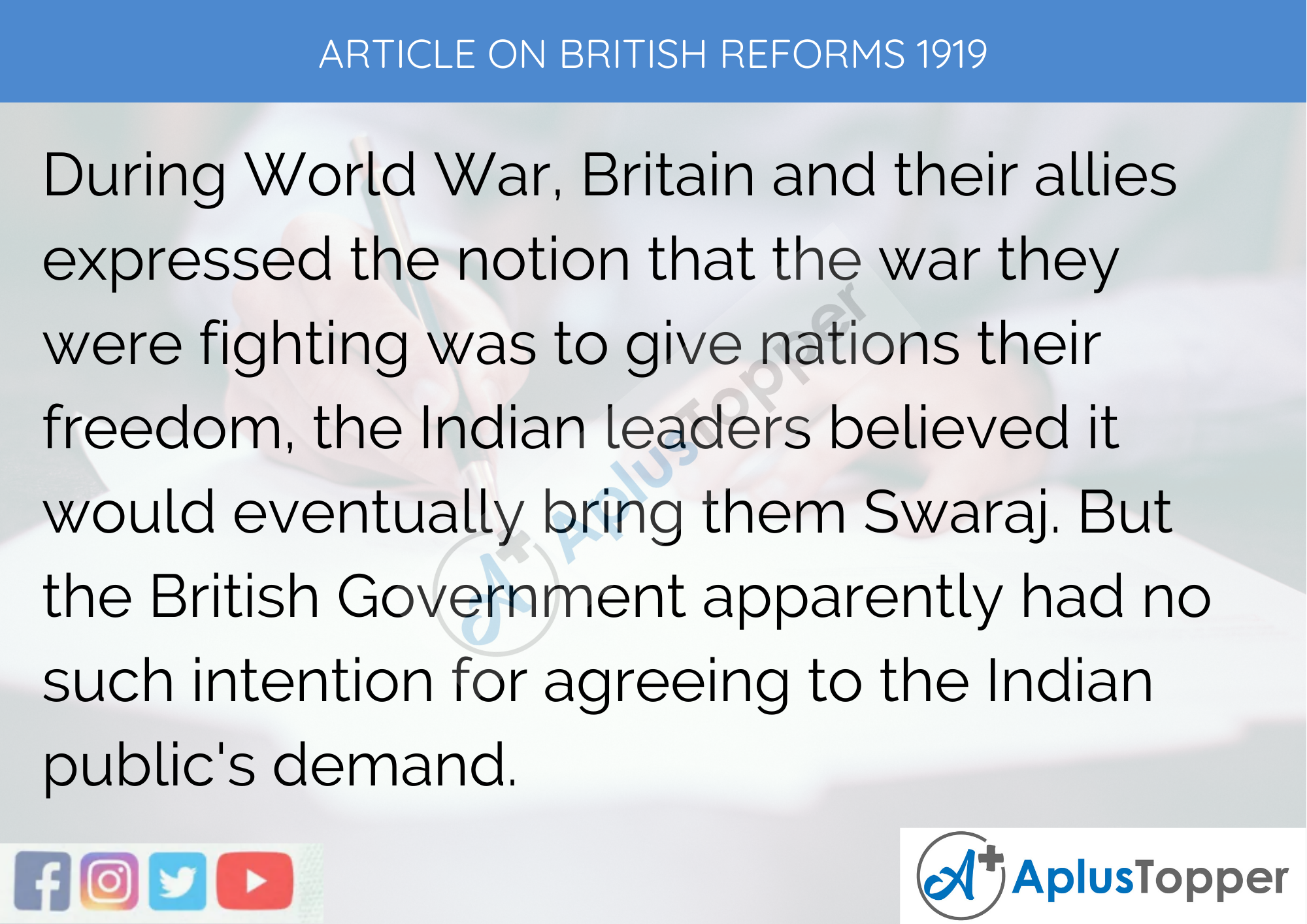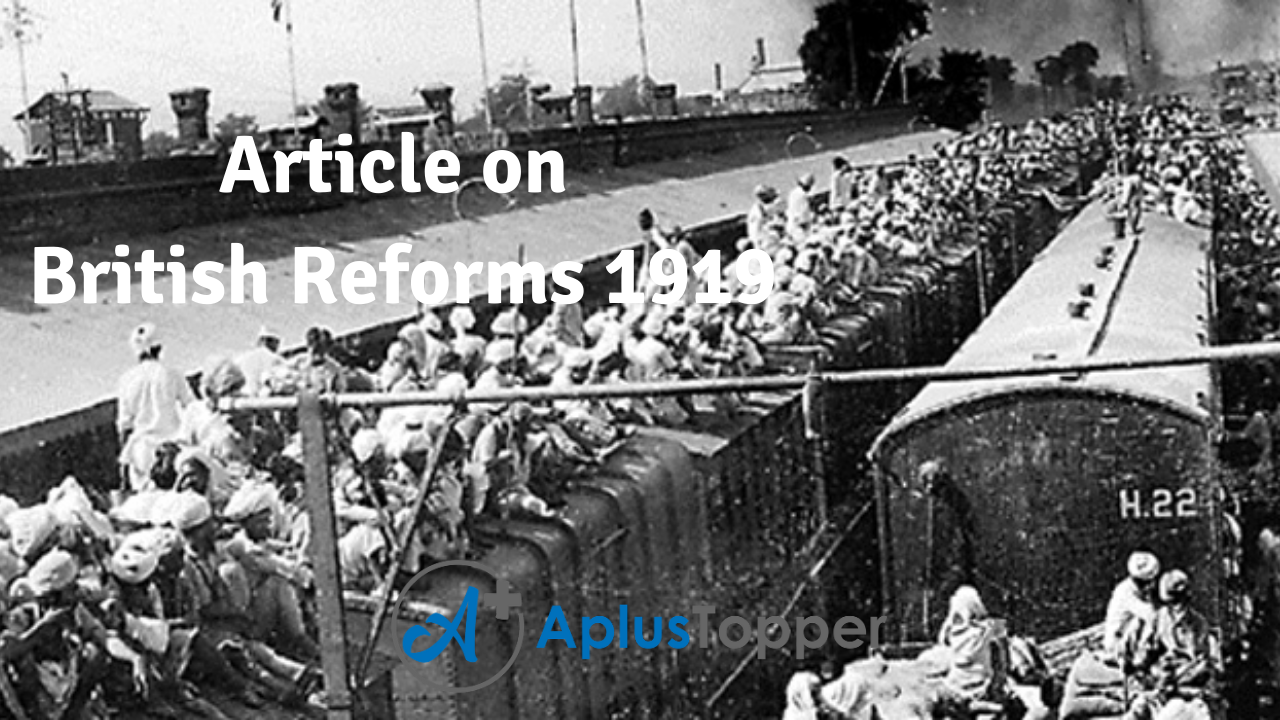Article on British Reforms 1919: The British Colonial Government of India introduced the British Reform of 1919 called the Montague-Chelmsford Reforms. These reforms were stated to establish a self-governing institution in India gradually. These reforms were outlined in the Mont-Ford Report (1918), and this was later used as the base for preparing the 1919’s Government of India Act.
You can read more Article Writing about people, sports, technology many more.
Long And Short Articles on The British Reforms 1919 for Students and Children in English
The British Reforms of 1919 is an important chapter in the history of Indian Independence. At one time or another, the students will be required to write about this concept in their assignments and exams. The long article on The British Reforms 1919 are useful for students of classes 7, 8, 9, and 10. And the short article on The British Reforms 1919 will come in handy for students of classes 1, 2, 3, 4, 5, and 6.

Long Article On British Reforms 1919 In English 500 Words in English
During World War, Britain and their allies expressed the notion that the war they were fighting was to give nations their freedom, the Indian leaders believed it would eventually bring them Swaraj. But the British Government apparently had no such intention for agreeing to the Indian public’s demand.
But in its place, the British Government introduced the British Reforms of 1919, which is also known as the Montagu-Chelmsford Reforms. These reforms brought noteworthy changes in the administrative system, and this was later declared as the Government of India Act (1919).
The features of the reforms were that the number of members in the then Indian Council was fixed to 12 and among which only three were to be Indians. And it also said that half of those 12 members selected must have lived in the country for more than ten years.
The number of members of the Executive Council of a Viceroy was made flexible, where he could choose as many members as he wished. The chosen councilor had the post for five years. Other than this, the Council of State and the Legislative Assembly of India together formed the Central Legislature.
The election processes of the Upper House and the Lower House was decided and was also very much controversial. But in the end, none of the voices of these elected members mattered because it was only the Viceroy who had a sole say in summoning, proroguing, and dissolving of Chambers.
Even though the British Reforms of 1919 introduced Diarchy but it was not free from many short-comings. The disadvantageous points being greater like the limited franchise, no equal or clear division of power between the Central and State, and the Viceroy’s authority over every matter was highly dissatisfactory.
But these changes were nothing compared to the ‘Swaraj’ that the Indians were hoping for at the end of the war. This gave rise to much discontent throughout the population. And observing this discontent among people, the British Government found a new strategy to repress the people and uprising again. Rowlatt Act that was based on Rowlatt commission was passed in March of 1919, and the assembly highly opposed it.
Many noteworthy leaders like Mohammad Ali Jinnah showed protest by resigning from his post and disgracing the Government, claiming them to be uncivilized. The sanctioning of such acts enraged the public, and that is when the British Government adopted new measures of repression by introducing the Black Act (1919).
After this, Mahatma Gandhi called for a countrywide protest, and that year 6th of April was observed at a National Humiliation Day. On that day, all businesses came to a standstill, and people demonstrated Hartals throughout the country.
The only good that came from such a protest was that it united the country people like never before. But for all the evils that the British Government had done on the public before, there was no way they would stay quiet. The British rulers resorted to taking brutal measures to bring these protests to a stop like dong lathi-charges and firings in several places across the country.
Short Article On British Reforms 1919 300 Words in English
The scheme of constitutional reforms that eventually led to the enactment of the British Reform of 1919 was already developed in 1918 by the Viceroy Lord Chelmsford and Edwin Montagu, who was the Secretary of the State of then. The majority of the Provincial Legislative Councils were to be elected because of the Council’s enlargement. And during this enlargement, the Provincial Government, under the system of Diarchy, were given more power.
Subjects like finance, law, and order were called the reserved subjects under this system. These remained under the direct control of the Governor. Other ministers of the legislature maintained the transferred subjects such as education, local self-government, public health, etc.
The British Government having control over the finance aspect made them capable of overruling any minister on any grounds. There were exactly two houses in the center of the legislature. Out of 144 potential candidates who were the total strength of the Lower Assembly, only 41 were nominated as the members. And the upper house of the Council State had 34 elected members and 26 nominated members.
The Executive Council led by the Governor-General was the ultimate super-power of the country, and the legislature had no virtual control over them at all. The control over the provincial Government was unrestricted by the Central Government of then. Since the right to vote was extremely restricted to a few people, in 1920, the recorded voters from the upper house were 17364, and the lower house was 909874.
Indian nationalists by then were no longer satisfied to be under the shadow of political power. The reform outline of 1918 was originally introduced by the British Government to subdue the uprising of India’s revolutionary activities. That is why, in August of 1918, the members of the Indian National Congress under the president-ship of Hasan Imam came together to attend a special meeting in Bombay to consider the reform proposals.

10 Lines On British Reforms 1919
- The British Reform of 1919 was also called the Mont-Ford Reforms.
- These reforms were named after Edwin Samuel Montagu and Lord Chelmsford.
- Edwin Samuel Montagu was at the post of Secretary of State for India.
- Lord Chelmsford was the Viceroy of India from 1916 to 1921.
- The reform demanded that three out of six members in the Viceroy’s Executive Council should be Indian.
- Separate electorates were to be established for Anglo-Indians, Europeans, Indian Christians, and Sikhs.
- Some of the functions of Secretary State of India were given to the High Commissioner for India, who had his office in London.
- The reform introduced in 1919 also separated the Central budget and the Provincial budgets.
- One of the mentionable merits of the Government of India Act of 1919 was that with the introduction of Diarchy, a responsible government system was introduced.
- One of the major advantageous and revolutionary aspects of the British Reforms of 1919 was that some women were given the right to vote for the first time.
FAQ’s on Article on British Reforms 1919
Question 1.
When was the Public Service Commission of India introduced?
Answer:
In 1926, the Public Service Commission of India was established for which the orders were given in the Government of India Act of 1919.
Question 2.
When did Mahatma Gandhi call for Satyagraha?
Answer:
Against the Rowlatt Act of 1919, Mahatma Gandhi called for nationwide Satyagraha in India.
Question 3.
State one limitation of the British Reforms 1919?
Answer:
The major limitation of the Government of India Act of 1919 was that the franchise was limited. It gave the British government ultimate supremacy being in their control, and it did not extend to common people.
Question 4.
Mention one merit of the British Reforms of 1919?
Answer:
One merit of the Government of India Act of 1919 was that it introduced the federal structure concept in India on a unitary basis where the numbers of Indian participants were also increased.
